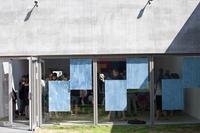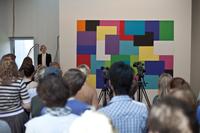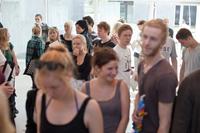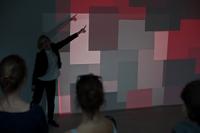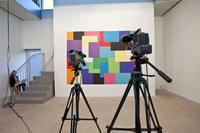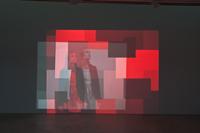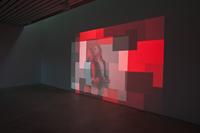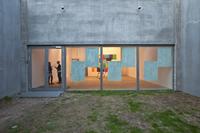*“I believe in encouraging the romanticization of a wonderful phenomenon. It is my own experience that a premature attempt to explain something that thrills you will destroy your perceptivity rather than increase it because your tendency will be to explain away rather than seek out. Postpone disillusionment, if it must come, to the last possible moment. Fly with your mind without assuming that nature has set a very special trap for you. […] Having enjoyed the phenomenon, we must return to earth to try to understand it, and I do not promise that we shall. First of all, let us look. Can these colors exist?” * (Edwin H. Land: “Color Vision: The case of a sleeping beauty or a case history in industrial research”, Edwin H. Land’s Essays. Edited by Mary McCann.)
In the exhibition The Dy(e)ing Light or the Case of a Sleeping Beauty, Danish artist Marie Kølbæk Iversen presents two projects both drawing on scientific experiments within the field of colour perception and representation. The exhibition changes during the run of the day, and whereas one of the installations, The Dy(e)ing Light, is ‘developed’ by the UV-light of the sun, the other, Land of Goethe, is only fully visible at night.
The Dy(e)ing Light consists of a line of white sheets of paper covered with photochromatic paint. Being developed by the UV-rays emitted by the sun, the royal blue strokes of paint disappear at sunset. The colour returns at dawn, however, turning the work into a reel time illustration of the central part the sunlight plays to the experience of colour phenomena.
The video installation Land of Goethe is based upon the scientific experiments conducted by Edwin H. Land in the 1950ies. In Land of Goethe the slide projectors are replaced by digital video projectors, whereby the recording and the transmittance are conducted simultaneously. Furthermore, the installation spans over two storeys: on the ground floor, two cameras record the image of a colourful collage paraphrasing Land‘s ‘Mondrian’ – an image used by Land for the development of his Retinex-theory on colour constancy. The signals of the cameras are transmitted to the projectors placed on the first floor. Both signals are b/w and colour separated; one camera is recording the image of the ‘Mondrian’ through a red filter, the other through a green filter. The green recording is projected through a neutral density-filter (which reduces the light intensity of the projector), while the red recording is projected through a red filter. The resulting image provides a notion of multiple colours despite the fact that the only measurable frequencies present in the projected image are red and white. By virtue of the simultaneous recording and transmittance, an interactive aspect is added to the installation further underpinning the interdependency of the individual’s sense perception and the surrounding world.
The exhibition is based on a research project conducted under the supervision of Henrik Boëtius from the Laboratory of Colour at the Royal Danish Academy of Fine Art, and the exhibition is produced with the kind support of the Danish Arts Council. Marie Kølbæk Iversen (*1981) graduated from the Department of Time-based Media at the Royal Danish Academy in 2008. She is the co-founder and editor of contemporary art journal Internationalistisk Ideale and had a residency at Gasworks in London in 2009. Recent exhibitions include “Ce n’est pas une image juste, c’est juste une image” at IMO and “Nat is Night Personified” at WAS. She has exhibited her work at Gasworks, Martin Asbæk Gallery, the Drawing Room, atelier atelier, Kunsthal Charlottenborg, Overgaden, and PS1/MoMA.
Photography by Per Andersen, Anne Kølbæk Iversen, and Marie Kølbæk Iversen
